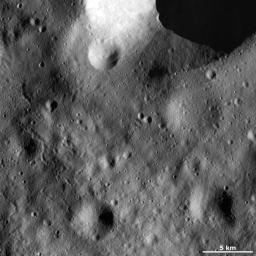Linear and Curvilinear Grooves
Caption:
This Dawn framing camera (FC) image of Vesta shows many linear and curvilinear grooves running roughly diagonally across the image. These grooves are much longer than they are wide: they are less than 1 kilometer (0.6 miles) in width and can be up to 10 kilometers long (6 miles). A particularly clear curvilinear groove is in the middle left of the image. It is wider than the other grooves and has a sinuous pattern. In the top of the image there is a large crater with a reasonably fresh rim. A smaller crater has hit the rim of the larger crater and part of the rim of the smaller crater is partially slumping into the larger crater. The part of the rim of the smaller crater that is slumping is much more rounded and degraded than the other part of the rim.
This image is located in Vesta's Gegania quadrangle, to the north of Vesta's equator. NASA's Dawn spacecraft obtained this image with its framing camera on Jan. 24, 2012. This image was taken through the camera's clear filter. The distance to the surface of Vesta is 272 kilometers (169 miles) and the image has a resolution of about 25 meters (82 feet) per pixel. This image was acquired during the LAMO (low-altitude mapping orbit) phase of the mission.
Background Info:
The Dawn mission to Vesta and Ceres is managed by NASA's Jet Propulsion Laboratory, a division of the California Institute of Technology in Pasadena, for NASA's Science Mission Directorate, Washington D.C. UCLA is responsible for overall Dawn mission science. The Dawn framing cameras have been developed and built under the leadership of the Max Planck Institute for Solar System Research, Katlenburg-Lindau, Germany, with significant contributions by DLR German Aerospace Center, Institute of Planetary Research, Berlin, and in coordination with the Institute of Computer and Communication Network Engineering, Braunschweig. The Framing Camera project is funded by the Max Planck Society, DLR, and NASA/JPL.
More information about the Dawn mission is online at
http://www.nasa.gov/dawn
and
http://dawn.jpl.nasa.gov
.
Cataloging Keywords:
| Name |
Value |
Additional Values |
| Target |
4 Vesta |
|
| System |
Main Belt |
|
| Target Type |
Asteroid |
|
| Mission |
Dawn |
|
| Instrument Host |
Dawn |
|
| Host Type |
Orbiter |
|
| Instrument |
Framing Camera (FC) |
|
| Detector |
|
|
| Extra Keywords |
Crater, Grayscale |
| Acquisition Date |
|
| Release Date |
2012-03-29 |
| Date in Caption |
2012-01-24 |
|
| Image Credit |
NASA/JPL-Caltech/UCLA/MPS/DLR/IDA |
| Source |
photojournal.jpl.nasa.gov/catalog/PIA15521 |
| Identifier |
PIA15521 |

 Planetary Data System
Planetary Data System
